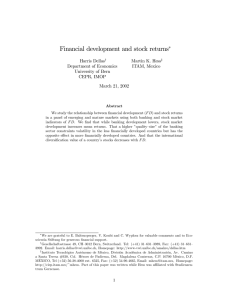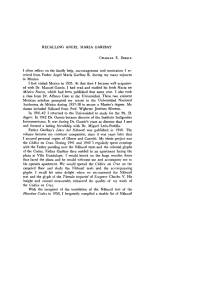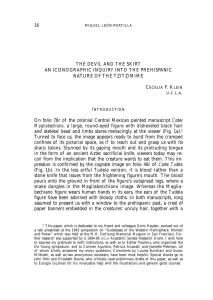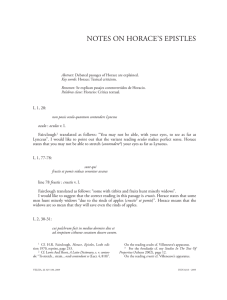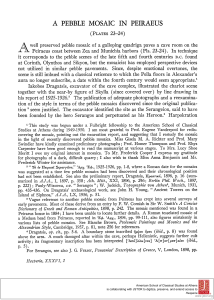THE BOBAN CALENDAR WHEEL` The Boban Calendar Wheel is so
Anuncio
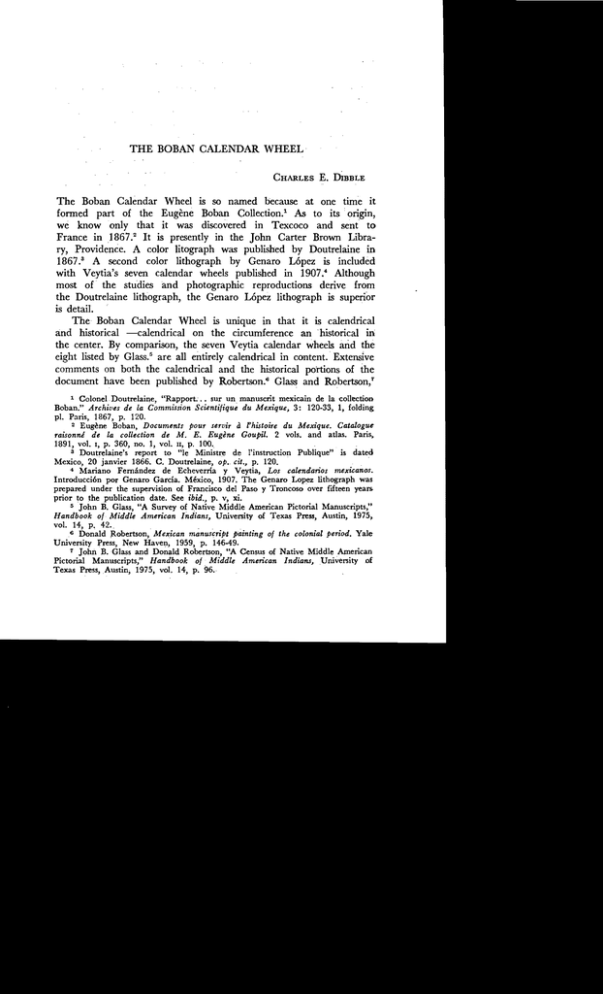
THE BOBAN CALENDAR WHEEL' CHARLES E. DIBBLE The Boban Calendar Wheel is so named because at one time it fonned part of the Eugene Boban Collection.1 As to its· origin, wé know only that it was discovered in Texcoco and sent' to France in 1867. 2 It is presentIy in the John Carter Brown Libra­ ry, Providence. A color litograph was published by Doutrelaine in 1867.3 A second color lithograph by Genaro López is íncluded with Veytia's seven calendar wheels published in 1907.4 Although most of' the studies and photographic reproductions derive from the Doutrelaine lithograph, the Genaro López lithograph is superior is detail. The Boban Calendar Wheel is unique in that it is calendrical and historical -calendrical on the circumference an 'historical in the center. By comparison, the seven Veytia calendar wheels arid the eight listed by Glass. 5 are all entirely calendrical in content.' Extenslve comments on both the calendrical and the historical pottions of the document have been published by Robertson.6 Glass and Robertson,7 1. Colonel, Doutrelair¡e, "Rapport;.. sur un, manuscrit mexicain de la collection Doban." Archives de la Commission Scientifique du Mexique, 3: 120-33, 1, folding pI. Paris, 1867, p. 120. 2 Eugene Doban, Documents pour servir ti l'histoire du Mexique. Catalogue raisonné de la collection de M. E. Eugene Goupil. 2 vols. and atlas. Paris, 1891, vol. 1, p. 360, no. 1, vol. Il, p. 100., 3 Doutrelaine's report to "le Ministre de I'instruction Publique" is dated , Mexico, 20' janvier 1866. C. Doutrelaine, op. cit., p. 120. ' 4 Mariano Fernández de Echeverrla y Veytia, Los calendarios mexicanos. Introducci6n por Genaro Garcia. México, 1907. The GenaroLopez lithograph was prepared under the supervision of Francisco del Paso y Troncoso over fifteen years prior to the publication date. See ibid., p. v, xi. 5 John D. Glass, HA Survey of ~ative Middle American Pictorial Manuscripts," Handbook 01 Middle American ¡:ndians, University of Texas Press, Austin, 1975, vol. 14, p. 42., . , 6 Donald Robertson, Mexican manuscriPt painting 01 the colonial periodo Yale University Press, New Haver¡, 1959, p. 146-49. 7 JOM D.Glass and Donald Robertson, nA Census of Native Middle American Pictorial Manuscripts," Handbook 01 Middle American Indians, University oí Texas Press, Austin; 1975, vol. 14, p. 96. 174 CHARLES E. DlBBLE Boban,8 Kubler and Gibson,9 Doutrelaine,lO comment briefly on its contento The calendrical part that íonns the perlphery oí the Codex has been studied and cited by Paso y Troncoso,ll Jonghe,12 and Caso 13 to verify their calendrical interpretations. The outer band consists oí a glyphic representation oí the eighteen twenty-day ritual "months" oí the Aztec calendar year. These are íollowed by íour year signs (Acatl, Tecpatl, Calli, Tochtli) and twenty day signs distributed in groups oí five days each. Each group oí íive days represents the nemontemi days íor each oí the íour year signs. To the leít oí the day signs the word nente. .. is visible. The "montbs" íollow in a c10ckwise sequence and the first "month" Quahuitlyehua is the íirst "month" in the Texcocan calendrical system.14 The name oí each "month" is written to the leít of the glyphic representation. Above each "month" glyph veyti días (twenty days) is written and below each one is anear oí maize centli or cintli, a glyphic representation oi cempohualli (twenty). The "month" glyphs are essentially variants oí representations found in other post-hispanic calendars. Kubler and Gibson have given an exhaustive comparison of "month" glypbs in their discus8Íon oí the Tovar Calendar.15 The inner circ1e is a blue bando Paso y Troncoso indicated that in the upper right quadrant he could detect thirteen rectangles which record a thirteen year span, and that the circular band in its entirety gives the fifty-two year cyc1e.16 The middle band contains a sequence oí footprints that begins at the upper right, at the foot of an individual wearing native attire -bre­ echclout and cape. The footprints end at the upper leít, where a E. Boban, op. cit., vol. 1, p. 360, no. 1. George Kubler and Charles Gibson. "The Tovar Calendar: An illustrated MeXicari manuscript of ca. 1585." Memoirs 01 the Connecticut Academ.)' 01 Arts and Sciences, vol. 11. New Haven, 1951, p. 56. 10 C. Doutrelaine, op. cit., p. 120-33. 11 Francisco del Paso y Troncoso, Descripci6n, historia )' exposición del c6dice pictórico de los antiguos Náuas que se conserva en la Biblioteca de la Cámara de Diputados de París. Florencia, 1898, p. 195-312. 12 Edouard de Jonghe, "Der altmexikanische Kalender" Zeitschrift lir Eth­ nologilJ, 38:485-512. Berlin, 1906. p. 495-96, fig. 3. 13 Alfonso Caso, Los calendarios prehispánicos. Universidad Nacional Aut6no­ ma de México, Instituto de Investigaciones Hist6ricas, México, 1967, p. 71-73. Caso ineludes color photographs oí the original and the Doutrelaine litbograph. u [bid., p. 38. 15 G. Kubler and C. Gibson, op. cit., p. 22-35. le F. Paso y Troncoso, op. cit., p. 302. 8 9 THE BOBAN CALENDAR WHEEL 175 similar individual appears in a somewhat differing posture. The word xiuh. " is written in front of theindividual at the rigth. This could conceivably read xiuhixua (the herb growsor the year is born) or xiuhixualiztli (the growing of theherb or the birth of the year). The word xiuhca. " is written behind the individual at the left. This could he read as xiuhcayotl (the affairs of the past year).17 The two words, ·the two individuals and the footprints couldthus indicate the lapsc of the 18 "month" cycle beginning with Quahuitlyehua and ending with lzcallami. Derivingfrom the blue band, dividing two footprints and between the "months" Atemoztli and Titítl, a hand grasps a bundle of herbs. Paso y Troncoso considers this to be an indication of the xiuhtzitzquilo ceremony; that the grasping of the herb (xiuitl) 01' year (xiuitl) in di­ cates the beginning of a new fifty-tow cycle and that this occurred in the "month" Tititl.'18 The ceremony is dcscribed by Sahagún: "Hence was it said that then were tied and bound our ycars, and that once again the years were newly laid hold of. When it was evident that the years lay ready to burst into Jife, everyone took hold of them, so that once more would start forth --once again- another :[period of] fifty­ two years".'1'9 In the corresponding Spanish text, Sahagún is more explicit regarding the xiuhtzitzquilo ceremony.20 In considering the central, or the historical part, Rohertson notes that the Codex has pietoríal forms drawn by two different hands, that Hand A painted mast of the Codex, but that Hand B, a less skilled hand, painted a two-story building, a church, a two-story building facing a one-story building and two temples on a pyramid in the four quadrants respectively. The sun in European style is also the work of Hand B.21 TheNáhuatl glosses, including the "month" names were n Fray Andrés de Olmos, Grammaire de la langue Nah'Uatl 0'11. Me:cicaine..• publiéc... par Rémi Siméon. Imprimerie NationaIe, Paris, 1875, p. 41.See especially note No. 2. 18 F. Paso y Troncoso, op. cit.,p. 302, 309. 19 Bemardino de Sahagún, Florentine Code:c: General History 01 the TMngs 01 New Spain. Arthur J. O. Anderson and Charles E. Dibble, trs. and eds.; 12 Books and Introductory Vol. The School oí American Research and the University oí Utah. 1950.1982. Book '7, p. 25. 20 Fray Bemardino de Sahagún, Historia general de las cosas de Nueva Espa­ ña. Angel Ma. Garibay K., ed. 4 vols. EditorialPorrua, México, 1956, \'01.' 2, p. 269-270. "y porque -éraprincipio de otros cincuenta y dos años, dec!an también :ciuhtzitzquilo, que quiere decir, 'se toma el año nuevo', y en señal de esto cada uno tocaba a las yerbas, para dar a entender que ya se comenzaba la cuenta de otros cincuenta y dos años." 21 D. Robertson,op. cit., p. 147-8. 12 176 "CHARLES E. DIBBLE ,added alter the painting of the Codex. These ,glosses intrude into the blue band and they circumvent the representation of the sun. Because of the limited space available to the artist, only a synoptic versión of Texcocan history was possible. The contents could conceivably be ,construed as an abbreviated extract from such codices as the Mapa Tlotzin or the Mapa Quinatzin. 22 In effect, a colonial perlod is added to the nomadic and sedentary life styles as depicted in the two alorem­ entioned codices. In the upper right quadrant is a mountain, tepell, and in the upper ldt quadrant an expanse of water, atl. Water-mountain, in atl in tepetl or atepetl, whether painted or written is the metaphor for city or town. Over the mountain a man wearing a colonial hat and holding a staff is seated on a woven reed mato The name reads don antonio pimenteI. A second person similarIy attired appears aboye the expanse of water. The name reads don hemando de chavez. Two Náhuatl glosses read,: yn • .. alcaldes. tetzcoco ypa xihuitl chicó tochtli. Ano. .. (The alcaldes of Texcoco in the year 7 Rabbit, in the year... ); auh yn axca ye yhui yahui. ti atl yn tepetl. ome atl a... aldes Regittores. alguaciles. alcalde mayor. (and presentIy conditions are SUCh23 in the city24 [on the day] 2 Water: alcaldes, regidores, alguaciles, alcalde mayor.) Don Antonio Pimentel TIahuitoltzin was the 12th ruler of Texcoco and, according to Sahagún, he ruled for six years.25 Other sources indicate that he ruled from 153726 or 1540 until 1564.21 According to the Proceso inquisitorial del cacique de Tetzcoco, Don Hemando de Chavez and Don Antonio Pimentel were contemporary alcaldes of Texcoco durlng the trial of Don Carlos Ometochtzin in 1539.:18 The speech scrolls emerging from the mountbs of the two rulers would indicate a conversation or their contemporaneousness. 22 Mapa Quinatzin, Mapa Tlotzin. In J. M. A. Aubin, Mémoires sur la peinture didactique et I'écriture íiguratíve des anciens melCÍ,cans, Précedés d'une introductíon para E. T. Hamy. París, 1885. 23 Read 'Ye 'Yhui 'Yauh. 24 C. Doutrelaine, op. cit., p. 130-131, reads and translates the passage as follows: auh 'Yn axean 'Ye 'Yhui 'Yahui 'Yn atl 'Yn eepetl - Et aujourd'hui va crois­ sant la ville. 25 B. de Sahagún, Florentine Codex, op. cit., Bock 8, p. 10. 26 Byron McAfee and Robert H. Barlow, uThe Titles oí Tetzcotzinco." Tlaloean 2:110-127, Azcapotzalco, 1946, p. 119. :27 Rémi Siméon, "Annales de Domingo Francisco de San Antón Muñ6n Chi­ malpahin Quauhtlehuanitzin, sÍxÍeme et septreme Relationes (1258-1612)." Rí-. bliotheque Linguistique Amirieaine, vol. 12. París. 1889, p. 240, 261. 28 Proceso inquisitoral del cacique de Tetzcoeo. Publicaciones de la Comisi6n reorganizadora del Archivo General y Público de la 'Nación. l. México, 1910, p. 19-22. THE BOBAN CALENDAR WHEEL 177 The year 7 Rabbit and the day 2 Water in the Náhuatl glosses could be 1538, 1590 or 1642. Caso reasons that 7 Rabbit 2 Water, 1538, is thedate the two officials wcre installed and that the Codex was painted at the same time or soon thereafter. 29 Robertson considers the Don Hernando mentioned to be Don Hernando Pimentel, a son of and successor to Antonio Pimentel, and he would consequently date the Codex after 1564.30 In the Iower half, two mlers, wearing cap~s and breechclouts and seated on woven reed seats with a back rest (tepotzicpalli), face each other. Between the speech scrolls are arrows (mitl), an obsidian sword (maquahuitl) and a shield (chimalli.) The arrows and shield eithcr painted or written (atl-chimalli) represent a metaphor for warfare. ,The information afforded us is that two mlers spoke of or declared war. From the Náhúatl glosses below we Ie~rn that the rulers are Nezahualcoyotl and Itzcoatl. The two templeª atop the pyramid to the right are those of the war god, Huitzilopochtli, and the rain god~ Tlaloc. The N áhuatl text reads as follows: N ~avalcoyotzin tetzcocu Nezahualcoyotzin was ruJer oí ytzcohuatzin. tenochti tlá. Texcoco, Itzcohuatzin was roler tlatoani catca. yehuátin oí Tenochtitlan. They declared quittohuaya. yn mitova. yo the so-called water-conflagration teoad yn tlachinolli yhua y (war). And Totoquihuatzin was tlacopá. yo totoquihuaztzin. roler oí Tlacopan. Not without amo ñe q'cuiya yo temochichi­ purpose did they take that with huaya yn da~otilmal1i. auh yo which one was arrayed: precious mastlatl. auh y cozcapetlatl. capes, and breechclouts, and plaited auh y matemecatl. auh y col1ars and armbands, and leather cotzehuatl auh yo quetzallal­ bands íor the calf of the leg, and piloni. yo te~acatl. y nacochtli. head bands with sprays of quetzal auh y xiuccactli quipachovaya. feathers, labrets, ear plugs and blue petlatl ycpalli. auh yo alteped. sandals. They governed the city31 auh yo cuitlapilli y atlapalli and the commoners. 32 And in this auh ¡nie onezca!. .. onehuapahualo manner were they trained,33 reared. The war indicated by the gIyphs and mentioned in the glosses would be the campaign against the Tepanec of Azcapotzalco that commenced in· theyear 1 Flint, 1428. Nezahualcoyotl and Itzcoatl A. Caso, op. cit., p. 72. D. Robertson, op. cit., p. 149. 31 Literally "they occupied the woven reed mat, the woven reed seat." S2 Literally "the tail feathers, the wing feathers." as Read onezcalti!o. 211 30 FIG. L Tecpoyo Achcauhtli teaches Tlotzinto roast rus Km. (Mapa Tlotzin). Fro. 2. Chichimec woman roasts serpent. (Mapa Quinatzin). B oban Calendar Wheel. (López engraving) THE BOBA N CALENDAR WHEEL 119 combined theirarmies and the squadrons were led by Nezahualeoyotl, Itzeoatl and Moteeuhzoma, respeetively. The suhordinate mentíon of Totoquihuatzin of Tlaeopan in the glosses and the failure to record him in the Codex may be due to the faet that his eoronation as ruler oI Tlacopan was subsequent to the Tepanee: war. By 1431 the Triple Alliance had been formed and Tlacopan had been aecorded a· lesser portion of the tribute.34 The arrayment cited in the glosses represents a partíal list of the clothing and decorations wÍth which the rulers were arrayed when they danced. Sahagún clearly indicates that these itcms were the exclusive privilege and prerogative of the rulers.llS . Across the bottont a native woman kneels in the entrance of a cave, facing a fire. A roan, likewise facing the fire, .holds a bow and arrow in his left hand a seeond arrow in his right hand. Both wear capes roade of grass or fibre. The Náhuatl text reads as follows: 86 Auh y ye huecauh. yn chichimeca. ca. .. CO Ol. ' . • •. pec V ouca atle ma qualli q'. '. caya. ~an oc yehuad y totod. ano mazad cov ... And in andent times the Chichimecs came to arrive at caves, mountains where 81 nothing was good .. TheX roasted 38 only birds orlll' deer, sepents.40 The Chichiroec couple poised before the fire and the accoropanying Náhuatl text indicate their nomadic life-style and imply their potential for cultural change. Both in glyphic style and content the scene can be related to scenes in Mapa 110tzin and Mapa Quinatzin. Both the glyphs and the Náhuatl text of Mapa Tlotzin inform us that a certain Tecpoyo Achcauhtli of Toltec extraetion from ChaIco accompanied Tlotzin as he hunted deer, rabbits, serpents and birds. For a first time Teepoyo Achcauhtli roastcd the kill Tlotzin had taken. For the first time he gave Tlotzin eooked food, for previously Tlotzin ate his kilI uncooked. As León-Portilla has ably noted, the scene reeords one of the roany steps in the gradual acculturation of the Chichimecs.4 1. 34 Fernando de Alva IxtlixochitI, Obras históricas, 2 voIs. Edición Edmundo O'Gorman. Universidad Nacional Autónoma de México, Instituto de Investiga­ ciones Históricas, México, 1975. vol. n. p. 79, 82. 35 B. de Sahagún, Florentine Codex, op. cit., Book 8, p. 27, 56. 3<l 1 am indebted to my colleague Dr. Arthur J. O. Anderson for suggestions ón the illegible portions of the texto 3. Read cacico oztoc, tepec in oncan. 38 Read quixcaya. 39 Read anote. 40 Read cOl/atto 4,1 Miguel Loon-Portilla, "El Proceso de aculturaci6n de los Chichimecas de 180 CHARLES E. DIBBLE A comparable scene depicting the Chichimec mode qf.· subsistence appears also in Mapa Quinatzin. Below a hunter and facing a fire, a woman is shown in the act of roasting a serpent. These similar sceneS in Mapa l10tzin and Mapa Quinatzin enable us to conceive the general import of the Chichimec couple and the Náhuatl glosses in the Boban Calendar Wheel. In ad judging the central portion of the Boban Calendar Wheel; the intrusive nature of the four buildings beco mes apparent. Note­ worthy is the lack of a place glyph and name glyphs for the six persons painted therein.. The glyphic metaphors water and mountain· for city, arrow and shield for war, the many metaphors included in the glosses, i.e., in all in tepetl, in teQatl in tlachinolli, petlall iepa/U, in cuitlapilli in atlapalli, suggest an earIy date for the painting of the Codex. Robertson's sug.gested date of Ca. 1564 seems reasonable. 42 BIBLIOGRAPHY BOBAN, Eugene 1891 Documents pour servir ti l'histoire du Mexique. Catalogue raisonné de la collection de M. E. Eugene Goupil. 2 vols. and atlas. Paris. CASO, Alfonso 1961 Los calendarios prehispánicos. Universidad Nacional Aut6noma de México, Instituto de Investigaciones Hist6ricas, México.· DOUTRELAINE, Colonel 1861 "Rapports... sur un manuscrit mexicain de la collection Boban." Archives de la Commission Scientifique du Mexique, 3: 120-33, 1 folding pI. Paris. GLASS, John B. 1915 "A Survey of Native Middle American Pictorial Manuscripts," Handbook o[ Middle American Indians, v. 14, Part IJI. University oí Texas, Press, Austin. GLASS, John B. and Donald Robertson 1915 "A Census oí Native Middle American Pictorial Manuscdpts," Handbook of Middle American Indians, v. 14, Part 1II. Univer· sity oí Texas Press, Austin. . X61otl". Estudios de Cultura Náhuatl, vol. 7. Universidad Nacional Aut6noma de México, Instituto de Investígaciones Hist6ricas, México, 1967. . 42 D. Robertson, op. cit., p. 149. CHE BOBAN CALENDARWHEEL 181 IXTLILXOCHITL, Fernando de Alva, 1975 Obr'as hist6ricas, 2 vols. Edición Edmundo O'Gorman, Univer­ sidadNacional Autónoma de México, Instituto de Investigacio­ nes Históricas, México. JONOHE, Edouard de 1906 "Der altmexikanische Kalender." Zeitschrift für Ethnologie, 38: 485-512. Berlin. KUBLER, George and Charles Gibson 1951 "The Tovar Calendar: An illustrated Mexican manuscript of ca. 1585." Memoirs 01 the Connecticut Academy of Arts and Sciences, vol. 11. New Haven. LEÓN-PORTILLA, Miguel 1967 "El proceso de aculturación de los Chichimecas de Xólotl." Es­ tudios de Cultura Náhuatl, vol. 7, Universidad Nacional Autó­ noma de México, Instituto de Investigaciones Hhistóricas, México. Mapa Quinatzin, Mapa Tlotzin 1885 In Aubin, J. M. A., Mémoires sur la peinture didactique et l'écriture figurative des anciens mexicains. Précedés d'une in­ troduction par E. T. Hamy. París. McAFEE, Byron and Robert H. Barlow 1946 "The Titles oí Tetzcotzinco". Tlalocan 2: 110-27. Azcapotzalco. OLMOS, Fray Andrés de 1875 Grammaire de la langue Nahuatl ou Mexicaine... Publiée.•. par Rémi Siméon. Imprimerie National. París. PASO y TRONCOSO, Francisco del 1898 Descripción historia y exposici6n del c6dice pict6rico de los an­ tiguos Náuas que se conserva en la Biblioteca de la Cámara de Diputados de Paris. Florencia. 1910 Proceso inquisitoral del cacique de Tetzcoco. Publicaciones de la Comisión reorganizadora del Archivo General y Público de la Na­ ción, 1, México. ROBERTSON, Donald 1959 Mexican manuscript painting of the early colonial periodo Yale University Press, New Haven. SAHAOÚN, Bernardino de 1956 Historia general de las cosas de Nueva España. Angel Ma. Ga­ ribay, ed. 4 vals. Editorial Porrua, México. 182 CHARLES E. DIDBLE 1950 Florentme Codex: General llistory 01 the ThiTigs of New Spain. . 19S2 A~thur J. O. Anderson and Charles E. Dibble, t~. and ed~. 12 Books and Introductory Vol. The School óf .Ámerican Research and the University of Utah. ,1,> SIMÉON, Rémi 1889 "Annales de Domingo Francisco de San Ant6nMuñ6n Chimal· pahin Quauhtlehuanitzin, sixieme et septieme Relations (1258­ 1612)." Bibliotheque Linguistique Américaine, vol. 12. Paris. .. VEYTIA, Mariano Fernández de EcheverrÍa y 1907 Los calendarios mexicanos. Introducción por Genaro GarcÍa. Mé­ xico. :: ·1 : .... ,


